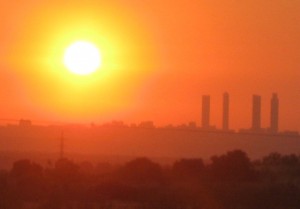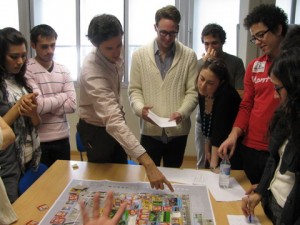Urban Planning: put the people in the middle!
 Last week we had a very interesting class on urban planning and sustainable cities by Dan Hill from Smart Urbanism. We talked about the challenges with the rapid urbanism and which problems it creates. A very relevant topic when considering the situation that more than the half of the world population lives in urban areas. It made me aware of how complex the issue is and how many stakeholders you actually have to involve into an urban planning process to be successful. The most sustainable project is one which works for the people. But still, the main focus is on environmental and economic sustainability. Unbelievable how many buildings have been built and have to be demolished again because the people don’t want to life in it. This shows the importance and at the same times the challenge to include the social network. It is invisible and difficult to measure. It gives life and is vital to the city.
Last week we had a very interesting class on urban planning and sustainable cities by Dan Hill from Smart Urbanism. We talked about the challenges with the rapid urbanism and which problems it creates. A very relevant topic when considering the situation that more than the half of the world population lives in urban areas. It made me aware of how complex the issue is and how many stakeholders you actually have to involve into an urban planning process to be successful. The most sustainable project is one which works for the people. But still, the main focus is on environmental and economic sustainability. Unbelievable how many buildings have been built and have to be demolished again because the people don’t want to life in it. This shows the importance and at the same times the challenge to include the social network. It is invisible and difficult to measure. It gives life and is vital to the city.
Projects which consider the community and actually build something what meets the needs of the community will last longer, because if the community feels responsible for it, it will take care of it and maintain it. The thing is to integrate them early and make them understand.
“Tell me and I forget. Show me and I remember. Involve me and I understand.” Chinese proverb
Clearly there will be trade-offs as well. The process might take longer or it is not that prestigious like it should be. But does this really outweigh the engagement of the community which actually should live there? Definitely: No!
«We need to walk, just as birds need to fly. We need to be around other people. We need beauty. We need contact with nature. And most of all, we need not to be excluded. We need to feel some sort of equality.» Enrique Peñalosa
 What if we focus not on the trade-offs but on the mutual benefits like R. Edward Freeman suggests in the Stakeholder Theory? I am sure there can be found many common interests among the individual interests, e.g. the architect is eager to design, the people need space to live and private and public open air areas, the municipality aims to get reelected and the developer is waiting for the new contract to develop the next area. All this can be achieved if all stakeholders come on one table and discuss. A great tool is to draw down the area and to have tokens which can be moved around. We played this urban planning game and had heated debates, however it brings up all interests and the solution is visible.
What if we focus not on the trade-offs but on the mutual benefits like R. Edward Freeman suggests in the Stakeholder Theory? I am sure there can be found many common interests among the individual interests, e.g. the architect is eager to design, the people need space to live and private and public open air areas, the municipality aims to get reelected and the developer is waiting for the new contract to develop the next area. All this can be achieved if all stakeholders come on one table and discuss. A great tool is to draw down the area and to have tokens which can be moved around. We played this urban planning game and had heated debates, however it brings up all interests and the solution is visible.
Further Information:
Smart Urbanism: http://www.smarturbanism.org.uk/
Stakeholder Theory from R. Edward Freeman: http://www.youtube.com/watch?v=Ih5IBe1cnQw



.png)
].gif)
.png)
].png)
].png)
].png)
.png)
].png)
.png)
